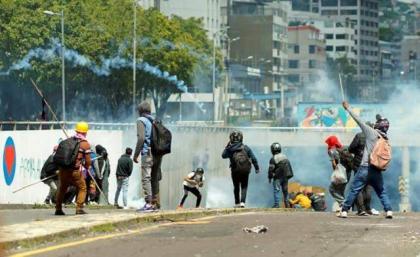
QUITO, June 22 (NNN-AGENCIES) — Police used tear gas to disperse hundreds of Ecuadorans taking part in a ninth day of Indigenous-led fuel price protests the military described as a “grave threat”.
Some 500 protesters among thousands who arrived in Quito from around the country in recent days were teargassed as they blockaded a street in the capital with burning tree branches.
They quickly regrouped to march with watery eyes on the CCE culture centre – traditionally used by Indigenous people to launch protests but requisitioned by police over the weekend to use as a base.
“The objective of today is to retake the Casa de la Cultura,” protester Wilson Mazabanda said before police used mace for a second time to break up the group amid rising tensions and little hope of a negotiated peace.
Earlier Tuesday, Defense Minister Luis Lara said Ecuador’s democracy “faces a grave threat from … people who are preventing the free movement of the majority of Ecuadorans” with widespread road blockades.
Flanked by the heads of the army, navy and air force, Lara warned the armed forces “will not allow attempts to break the constitutional order or any action against democracy and the laws of the republic”.
Called by the powerful Confederation of Indigenous Nationalities of Ecuador (Conaie), demonstrations since June 13 have seen roads barricaded nationwide at a cost of hundreds of millions of dollars to the economy.
Dozens of people, police and civilians, have been injured.
Conaie – credited with helping topple three presidents between 1997 and 2005 – called the demonstrations as Ecuadorans increasingly struggle to make ends meet.
Indigenous people comprise more than a million of Ecuador’s 17.7 million inhabitants and wield much political clout, but are disproportionately affected by rising inflation, unemployment and poverty exacerbated by the coronavirus pandemic.
Conaie has vowed to maintain the protests until its demands are met.
Thousands of protesters, many of whom had traveled to Quito on foot and on the backs of trucks, took to the streets afresh on Tuesday, some wielding sticks, fireworks and makeshift shields made of road signs.
Fuel prices have risen sharply since 2020, almost doubling for diesel from US$1 to US$1.90 per gallon and rising from US$1.75 to US$2.55 for gasoline.
Conaie is demanding a price cut to US$1.50 a gallon for diesel and US$2.10 for gasoline.
It also wants jobs and food price controls.
The movement has since been joined by students, workers and other Ecuadorans feeling the economic pinch.
Dozens have been arrested, according to human rights observers.
Lasso on Monday extended a state of emergency to cover six of the country’s 24 provinces, with a nighttime curfew in the capital Quito, as he sought to curtail the countrywide show of anger.
The president said in a video on Twitter Monday that the protesters “do not want peace”.
“They seek chaos. They want to eject the president,” he charged.
Ecuador is losing about US$50 million a day as a result of the protests, official figures show, without counting oil production – the country’s main export product.
State-owned Petroecuador has reported almost 64,300 barrels in lost production because of more than 230 wells shuttered by demonstrations in the Amazon.
Ecuador’s parliament voted 81 to 56 late Monday in favour of a resolution urging the government to conduct a “serious, clear and honest” dialogue with protesters, mediated by the United Nations, Red Cross, universities and the powerful Catholic Church.
In 2019, Conaie-led protests left 11 people dead and more than 1,000 injured but forced then-president Lenin Moreno to abandon plans to eliminate fuel subsidies. — NNN-AGENCIES






